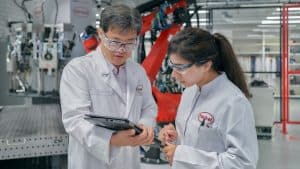Henkel collaborates with OEMs and battery producers to address the biggest problems related to EV battery technology in its quest to invent for zero-emission mobility.
E-mobility designs objectives that improve EV performance, dependability, and safety and establish a high bar for battery engineers. The design process for battery electric vehicles becomes more complicated as a result of navigating regulatory compliance, promoting carbon emission reductions across the whole value chain, and accelerating development timelines. Innovation is a crucial component of effectively addressing these challenges.
Modern solutions are required for complex design requirements.
Customers of EVs desire a wider driving range, quicker charging, and reasonable prices. Additionally, OEMs and battery manufacturers place a high priority on thermal safety and crash performance. OEMs and their partners in battery development are taking action to properly facilitate the switch to e-mobility. Henkel enables battery and original equipment manufacturers (OEMs) to overcome design and assembly challenges with cutting-edge material solutions as they make the transition to e-mobility happen.
Henkel’s capabilities for innovation and e-mobility are constantly growing across a number of focused initiatives. For instance, Henkel has introduced the following over the past few years:
- An accomplished and different” Fuel the Potential” battery innovation team,
- A brand-new, cutting-edge Battery Engineering Center,
- Through the use of modern mini integration, advanced modeling and simulation capabilities,
- New patents, market-leading formulations of multi-functional products, and
- A committed group of debonding technology specialists.
We’ll try to go into more detail about some of these examples in this article, showcasing the innovation synergies provided by Henkel’s very competent organization.
Team “Fuel the Future”
Henkel has gathered a global team of battery experts under the name” Fuel the Future” to foresee and address problems and solutions in battery technology and materials. The team is made up of industry experts in a variety of fields, including cell manufacturing, battery safety, debonding and battery recycling, and more.
They strengthen Henkel’s connections in the battery ecosystem by working directly with customers. These industry insiders participate in associations and speak for Henkel at conferences as thought leaders in addition to providing strong customer service.
New battery engineering facilities to improve e-mobility
Henkel increased its investment in e-mobility by launching a brand-new facility that advances customer collaboration. Henkel then runs a Battery Engineering Centre within its €130m” Inspiration Centre Düsseldorf” to assist customers in expediting the development of solutions for crucial innovation areas like battery safety, sustainability, and infrared management. In this first-of-its-kind facility, application engineers, innovation and product development experts, and customers work together to solve their most pressing problems under the guiding principle of “innovating for zero-emission mobility.”
Customers can find two different facilities at the Battery Engineering Center: a Battery Application Center with production-scale automatic dispensing equipment, and an Battery Test Center that can handle entirely charged batteries and test them in different environmental conditions, such as temperature and humidity. The Battery Engineering Center is prepared to manage simulation, dispensing, testing, and analysis projects on all battery systems as a whole.
Sophisticated simulation and modeling
Henkel’s cutting-edge modeling and simulation capabilities enable him to almost predict the performance of materials under a range of diverse conditions by drawing on his extensive knowledge of the materials and decades of data collection. Henkel’s modeling and simulation specialists virtually apply various material combinations to the “digital twins” of customers ‘ batteries that they have created. This assists in identifying the best material combination while also saving time and resources.
Customers work with Henkel to model and simulate targeted safety and efficiency through thermal management and thermal runaway management, using numerical finite element methodologies ( FEMs) and system simulations to produce quick verifiable results. This is especially true when it comes to the battery development process.
Fast charging, acceleration, fluid load, and thermal runaway load are a few examples of digital models used to simulate real-world battery scenarios. Moreover, simulations aid in predicting thermal performance metrics like the battery pack’s need for effective cooling power, heat transfer efficiency, and temperature distribution. These high-quality simulations can forecast how optimized Henkel materials will assist the battery system in reducing heat in the event of a possible thermal event.
Utilizing large data to formulate materials
Henkel has spent many decades developing, comprehending, and documenting the vast array of formulas in its e-mobility product portfolio because typical formulating is incredibly complex. The thousands of discoveries and pieces of information gathered to date are stored in this great data resource. Henkel is able to simulate product behavior using various physics and performance parameters under a variety of conditions thanks to this. By enabling large data to inform electronic material models, this eliminates repeated tasks. As a result, the depth of data available increases, accelerating innovation for Henkel customers.
Introducing fresh innovations to support a broad product line
Henkel’s innovation efforts, which aim to increase functional integration across important Hengkel adhesive technologies, have resulted in fresh, bespoke formulations that drive the best solutions for safer, more effective, and more responsible batteries.
For instance, Henkel has created usable gasketing material in the form of a patented, detachable seal that speeds up and simplifies battery box access. This makes it easier to remove the lids from battery packs for servicing, reuse, repurposing, or recycling without compromising the structure of the battery boxes.
Henkel provides sensitive electrode coatings inside the battery cells to enable the new “dry electrode” manufacturing process, enabling battery manufacturers to make batteries in a more long-lasting, effective, and effective manner.
Also, Henkel provides a range of battery safety materials, including battery protection coatings, which can be produced and applied with efficiency, giving battery manufacturers more assurance that their systems will react effectively and reliably in the unlikely event of thermal runaway.
Future of zero-emission mobility: Looking back
Henkel puts OEMs and battery manufacturers on the path to proven solutions that support secure, green, efficient, and economical battery systems by combining exceptional products with modeling and simulation capabilities as well as real-world testing and validation.
Henkel has taken the initiative by making audacious investments in innovation, reevaluating battery design and assembly, and challenging presumptions. Henkel is leading the way with an unmatched combination of modeling, simulation, product innovation, performance testing, and real-world validation through the opening of the Battery Engineering Centre.
Future battery engineering center launches in the US and China are expected to more and more quickly than ever accelerate e-mobility solutions on a global scale.













